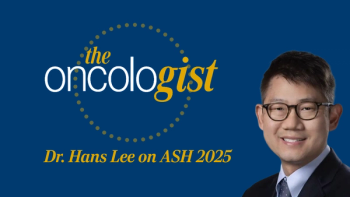
Allogeneic SCT Shows Efficacy in TP53+ AML and MDS
Melhem M. Solh, MD, discusses results of a study investigating allogeneic stem cell transplant in patients with myelodysplastic syndrome and acute myeloid leukemia with a TP53 mutation, previously presented at the 2022 Transplantation & Cellular Therapy Meetings.
Melhem M. Solh, MD, a blood and marrow transplant and leukemia program physician and medical director for the Cellular Therapy Program at Northside Hospital, discusses results of a study investigating allogeneic stem cell transplant (SCT) in patients with myelodysplastic syndrome (MDS) and acute myeloid leukemia (AML) with a TP53 mutation, previously presented at the 2022 Transplantation & Cellular Therapy Meetings.
Solh’s group at Northside Hospital looked at post-transplant outcomes for 30 patients in their SCT program, since TP53 is associated with poor outcomes. When looking at outcomes, the 1-year overall survival (OS) rate was 62%, the 1-year disease-free survival (DFS) rate was 42%, 1-year rate of relapse was 51%, and the post-relapse survival rate was 19%. When looking at patients with both TP53 mutations and deletion 17p (del[17p]), the 1-year OS rate was 73% and the DFS rate was 53%. The 3-year DFS rate was 27% for this subgroup.
The main reason for transplant failure was disease relapse, whether or not patients had both a TP53 mutation and del(17p). When looking at factors related to outcomes, OS, DFS, and relapse rate appeared to be associated with disease risk. Notably, in this patient set, fully matched SCT recipients had poorer outcomes for relapse rate than those who received transplants from haploidentical or unrelated donors.
TRANSCRIPTION:
0:08 | As we move into the outcomes for this patient population, the 1-year OS was 62%, DFS was 42%, relapse rate was 51%, and the post-relapse survival, patients who were alive post-relapse at 1 year, was 19%. Looking at the specific subgroups of patients who have a TP53 mutation and del(17p), the numbers were similar with OS and DFS [at 73%] and 53%, [respectively] at 1 year, and that goes down to 27% at 3 years [for DFS]. The main reason for transplant failure was relapse in the TP53 alone or the TP53 plus del(17p).
When we looked at factors associated with outcomes and responses, we really didn't see [much]—No. 1, keep in mind, this is a small study, there are only 30 patients, so we may not have much power to detect any variability. But when you look at OS, the DRI or the Disease Risk Index was a main factor in picking [out] patients who did worse versus patients who did better. For DFS, it was the same story that disease risk was the main contributor to this. For relapse, we noticed 1 interesting finding, that patients who had a matched-sibling donors did poorly compared [with] patients who get either an unrelated-match donor or a haploidentical donor. Again, at relapse, the higher disease risk was correlated with a higher relapse. There was no difference in outcomes [whether] patients have del(17p) or if they did not have del(17p).









































